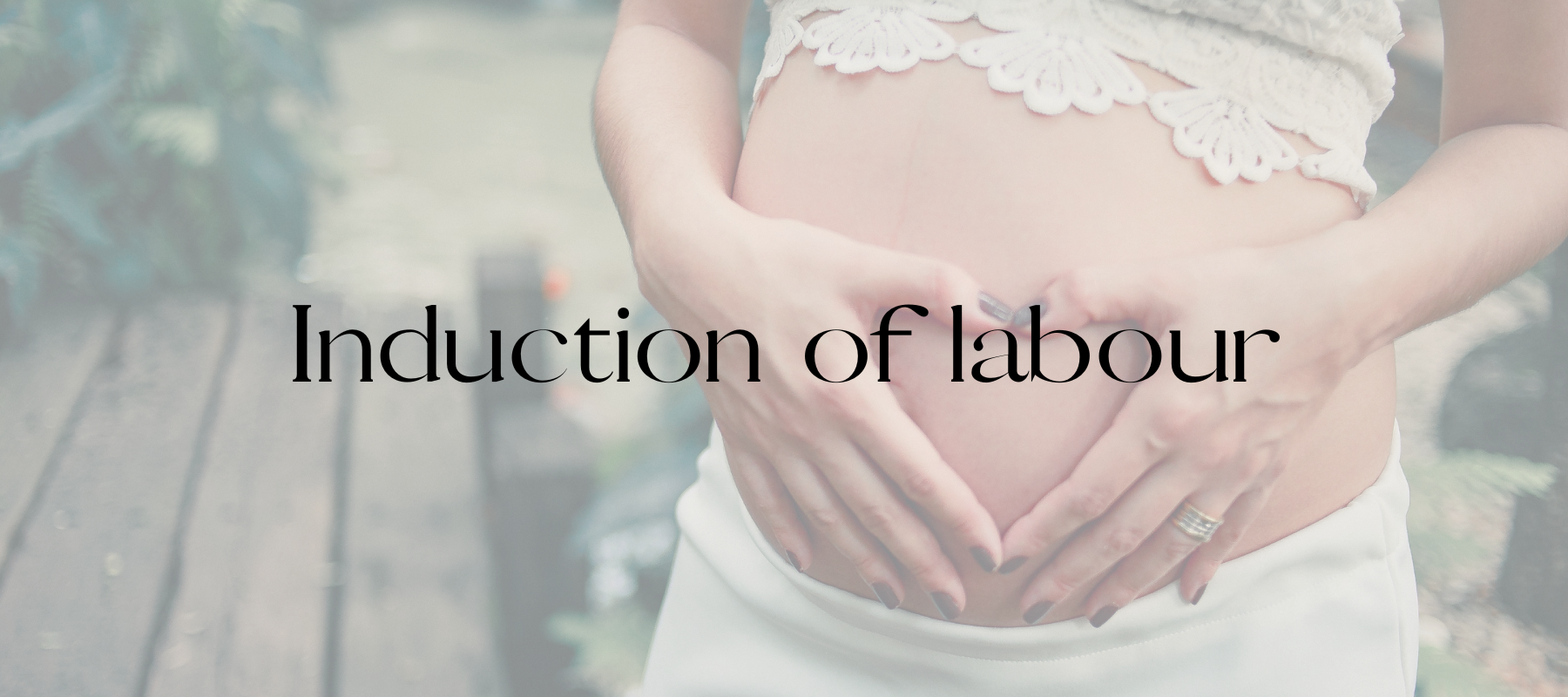Labour generally commences naturally between 37-42 weeks of pregnancy. During this time, the cervix starts to soften and dilate, contractions begin and the waters may or may not break.
If labour does not start for whatever reason, or there are complications in your pregnancy – your doctor may recommend an induction. This involves inducing your body’s natural processes by way of mechanical and/or chemical stimulation.
Induction is becoming increasingly common. It’s estimated about 1 in 3 women in Australia have an induced labour.
If your labour is induced, studies show you are more likely to require more medical intervention such as the use of fetal monitoring equipment, instrumental delivery and epidural analgesia.
You should only be offered an induction of labour if there is a risk to you or your baby’s health.
Some of the most common reasons you may be offered an induction are:
- PROM, Pre-labour Rupture of membranes. Your waters break but labour doesn’t establish. This is often referred to as ‘Augmentation’ rather than Induction, as your body has already started the process naturally!)
- High or rising blood pressure, particularly if progressing to involve other organ systems as well. (Kidney and Liver function most commonly impacted)
- You are overdue (over 41 weeks pregnant)
- Poorly controlled Gestational Diabetes
- Twins or multiple birth
- Your baby is not growing well (IUGR - Intrauterine Growth Restriction)
- Your baby is growing faster and bigger than expected (Macrosomia)
- Changed or decreased fetal movements
Methods of induction
Induction often happens in 2 stages, cervical ‘ripening’ and the establishment of contractions.
This is because your cervix typically starts out 2-3cm long and closed. This resembles a ‘tunnel’ and means there are essentially ‘two doors’ to the uterus and baby. These are called the internal and external OS. This tunnel needs to shorten, which means the cervix needs to ‘efface’. We refer to this in labour as ‘thinning out, softening, becoming shorter.’
Sometimes, the external OS can be dilated a small amount, but the internal OS (closest to baby) is closed. Sometimes both the internal and external OS are closed, or both open! All are normal, and your doctor or midwife will determine, with your consent, how ready your body is for labour, and what is the best way to induce your labour if needed.
Part One – Preparing your Cervix
Prostaglandins
Prostaglandin is one of the naturally occurring hormones that help to prepare your cervix for labour.
A synthetic version of Prostaglandin has been developed in order to mimic your body’s natural response and help soften, shorten and start to dilate your cervix in preparation for labour.
This is achieved by placing either a prostaglandin gel (called Prostin®) or a pessary (called Cervidil®) in the little space behind your cervix (the space is called the posterior fornix).
The pessary resembles a paper-thin tampon with a string that can be accessed from outside the vagina. It is often preferred in higher risk inductions, or for mothers who have already had a baby previously, as the pessary can be removed if needed.
Preparing the cervix generally takes several hours, and a second dose of gel or Cervidil may be needed 6-8 hours later for appropriate effect. Everyone responds differently to synthetic hormones, often due to varied levels of your natural hormones already in circulation. This is why it is difficult to predict how your cervix, uterus and baby will respond to this stage.
For this reason, fetal monitoring is recommended to ensure your baby’s wellbeing and ensure your uterus isn’t overstimulated from the prostaglandins.
Balloon catheter
Prostaglandins aren’t for everyone! For example, if you’ve had a caesarean previously, or a reaction to prostaglandins, your doctor may choose to use a balloon catheter (called a Foley’s or Cooks® catheter!) to try prepare your cervix instead.
This catheter is a thin tubing that is inserted into the cervix and two balloons are inflated with saline, with your cervix between the balloons. This places pressure on the cervix, encouraging it to dilate. The balloons will usually stay in place for several hours until they fall out naturally on their own – indicating the cervix has started to open/dilate.
Part Two – Establishing Contractions
‘Artificial Rupture of Membranes (ARM)’ – breaking your waters!
When your waters have not broken naturally, and labour hasn’t started – you may need an ARM. This is achieved by your midwife or doctor inserting a thin hook-like instrument into your vagina and making a small hole in your baby’s amniotic sac.
Often the sac of water can pool around your baby’s head (called forewaters) ‘padding’ the head and reducing the internal pressure against the cervix. This pressure is important during induced labour, and for this reason its usually recommended that your waters are artificially broken before moving onto the next stage.
To be able to break your waters, your cervix (both external and internal OS) needs to be dilated at least 1-2cms.
Oxytocin, the hormone drip
The hormone Oxytocin is one of the major hormones responsible for labour, particularly for the establishment and continuation of contractions. A synthetic version of Oxytocin (called Syntocinon®, or Pitocin® in the US) is used during inductions of labour.
It is administered intravenously through a cannula in your hand or arm. The oxytocin drip is titrated carefully by your midwife and doctors to ensure your contractions build in strength and frequency as safely as possible. They will continue to monitor you and your baby closely throughout this process to ensure you aren’t contracting too much (or too little) and how you both respond to these changes.
FAQ’s
How long will the induction take?
Its very difficult to predict how long your induction might take. This is because everyone’s body responds differently! It can take anywhere from a few hours to as long as 2-3 days!
If you are <37 weeks and it’s your first baby, its likely your induction process will take longer. If you have laboured before, or have a history of fast labours then your induction process is more likely to be faster!
Similarly, if your cervix has already begun to soften and dilate on its own, or your waters have broken – this usually reduces the amount of time you’ll need to establish into labour.
What are some of the risks associated with induction?
Its important that you are aware of the benefits and associated risks of induction while taking into consideration the reasons why you have been offered one.
When making your choice, ask your doctor:
- Why is induction being recommended?
- What are the risks to you and your baby if you wait for the natural onset of labour?
- What is the most likely method of induction chosen for you and its associated risks
- When and where this induction should take place
- Any issues you need to be aware of?
- What happens if the induction does not work?
Sometimes, the induction may not work. This can be for varied reasons, and it’s important for your healthcare provider to facilitate your ability to make informed decisions throughout this process.
You may require further time, a different induction method or a Caesarean section in these instances. Your doctor should discuss all these options with you.
What if I don’t want an induction?
Induction is certainly not most women’s first preference. Its commonly known that an induced labour can be more painful than a natural labour. And, of course, there are risks associated with all types of medical intervention. However, there are also risks associated with NOT intervening in many cases. It’s important you understand your specific risks of waiting and weigh these against the risks of induction. This should help you decide what is right for you.
Written by Keryn Thompson RM & IBCLC (L-301766)
References
Coates, D, Homer, C, Wilson, A, Deady, L, Mason, E, Foureur, M & Henry, A 2020, ‘Induction of labour indications and timing: A systematic analysis of clinical guidelines’, Women and Birth, vol. 33, no. 3, pp. 219–30, viewed 10 November 2022, <https://doi.org/10.1016/j.wombi.2019.06.004>.
Delaney, M & Roggensack, A 2017, ‘No. 214-Guidelines for the Management of Pregnancy at 41+0 to 42+0 Weeks’, Journal of Obstetrics and Gynaecology Canada, vol. 39, no. 8, p. e164-e174, viewed 10 November 2022, <https://doi.org/10.1016/j.jogc.2017.04.020>.
de Vaan, MD, ten Eikelder, ML, Jozwiak, M, Palmer, KR, Davies-Tuck, M, Bloemenkamp, KW, Mol, BW & Boulvain, M 2019, ‘Mechanical methods for induction of labour’, Cochrane Database of Systematic Reviews, 18 October, viewed 10 November 2022, <https://doi.org/10.1002/14651858.cd001233.pub3>.
Kortekaas, JC, Bruinsma, A, Keulen, JK, van Dillen, J, Oudijk, MA, Zwart, JJ, Bakker, JJ, de Bont, D, Nieuwenhuijze, M, Offerhaus, PM, van Kaam, AH, Vandenbussche, F, Mol, BW & de Miranda, E 2014, ‘Effects of induction of labour versus expectant management in women with impending post-term pregnancies: the 41 week – 42 week dilemma’, BMC Pregnancy and Childbirth, vol. 14, no. 1, viewed 10 November 2022, <https://doi.org/10.1186/1471-2393-14-350>.
Mandruzzato, G, Alfirevic, Z, Chervenak, F, Gruenebaum, A, Heimstad, R, Heinonen, S, Levene, M, Salvesen, K, Saugstad, O, Skupski, D & Thilaganathan, B 2010, ‘Guidelines for the management of postterm pregnancy’, Journal of Perinatal Medicine, vol. 38, no. 2, viewed 10 November 2022, <https://doi.org/10.1515/jpm.2010.057>.
Marconi, AM 2019, ‘Recent advances in the induction of labor’, F1000Research, vol. 8, p. 1829, viewed 10 November 2022, <https://doi.org/10.12688/f1000research.17587.1>.
McCarthy, FP & Kenny, LC 2014, ‘Induction of labour’, Obstetrics, Gynaecology & Reproductive Medicine, vol. 24, no. 1, pp. 9–15, viewed 10 November 2022, <https://doi.org/10.1016/j.ogrm.2013.11.004>.
Middleton, P, Shepherd, E, Flenady, V, McBain, RD & Crowther, CA 2017, ‘Planned early birth versus expectant management (waiting) for prelabour rupture of membranes at term (37 weeks or more)’, Cochrane Database of Systematic Reviews, 4 January, viewed 10 November 2022, <https://doi.org/10.1002/14651858.cd005302.pub3>.
Middleton, P, Shepherd, E, Morris, J, Crowther, CA & Gomersall, JC 2020, ‘Induction of labour at or beyond 37 weeks' gestation’, Cochrane Database of Systematic Reviews, 15 July, viewed 10 November 2022, <https://doi.org/10.1002/14651858.cd004945.pub5>.
Mishanina, E, Rogozinska, E, Thatthi, T, Uddin-Khan, R, Khan, KS & Meads, C 2014, ‘Use of labour induction and risk of cesarean delivery: a systematic review and meta-analysis’, Canadian Medical Association Journal, vol. 186, no. 9, pp. 665–73, viewed 10 November 2022, <https://doi.org/10.1503/cmaj.130925>.
Muglu, J, Rather, H, Arroyo-Manzano, D, Bhattacharya, S, Balchin, I, Khalil, A, Thilaganathan, B, Khan, KS, Zamora, J & Thangaratinam, S 2019, ‘Risks of stillbirth and neonatal death with advancing gestation at term: A systematic review and meta-analysis of cohort studies of 15 million pregnancies’, PLOS Medicine, vol. 16, no. 7, p. e1002838, viewed 10 November 2022, <https://doi.org/10.1371/journal.pmed.1002838>.
Organization, WH 2014, WHO Recommendations for Augmentation of Labour, WHO Regional Office for the Western Pacific.
Roos, N, Sahlin, L, Ekman-Ordeberg, G, Kieler, H & Stephansson, O 2010, ‘Maternal risk factors for postterm pregnancy and cesarean delivery following labor induction’, Acta Obstetricia et Gynecologica Scandinavica, vol. 89, no. 8, pp. 1003–10, viewed 10 November 2022, <https://doi.org/10.3109/00016349.2010.500009>.
Saccone, G, Della Corte, L, Maruotti, GM, Quist‐Nelson, J, Raffone, A, De Vivo, V, Esposito, G, Zullo, F & Berghella, V 2019, ‘Induction of labor at full‐term in pregnant women with uncomplicated singleton pregnancy: A systematic review and meta‐analysis of randomized trials’, Acta Obstetricia et Gynecologica Scandinavica, vol. 98, no. 8, pp. 958–66, viewed 10 November 2022, <https://doi.org/10.1111/aogs.13561>.
Sinkey, RG, Lacevic, J, Reljic, T, Hozo, I, Gibson, KS, Odibo, AO, Djulbegovic, B & Lockwood, CJ 2018, ‘Elective induction of labor at 39 weeks among nulliparous women: The impact on maternal and neonatal risk’, PLOS ONE, vol. 13, no. 4, p. e0193169, viewed 10 November 2022, <https://doi.org/10.1371/journal.pone.0193169>.
Sotiriadis, A, Petousis, S, Thilaganathan, B, Figueras, F, Martins, WP, Odibo, AO, Dinas, K & Hyett, J 2018, ‘Maternal and perinatal outcomes after elective induction of labor at 39 weeks in uncomplicated singleton pregnancy: a meta‐analysis’, Ultrasound in Obstetrics & Gynecology, vol. 53, no. 1, pp. 26–35, viewed 10 November 2022, <https://doi.org/10.1002/uog.20140>.
Souter, V, Painter, I, Sitcov, K & Caughey, AB 2019, ‘Maternal and newborn outcomes with elective induction of labor at term’, American Journal of Obstetrics and Gynecology, vol. 220, no. 3, pp. 273.e1–273.e11, viewed 10 November 2022, <https://doi.org/10.1016/j.ajog.2019.01.223>.
Thomas, J, Fairclough, A, Kavanagh, J & Kelly, AJ 2014, ‘Vaginal prostaglandin (PGE2 and PGF2a) for induction of labour at term’, Cochrane Database of Systematic Reviews, 19 June, viewed 10 November 2022, <https://doi.org/10.1002/14651858.cd003101.pub3>.
Wolff, SL, Lorentzen, I, Kaltoft, AP, Schmidt, H, Jeppesen, MM & Maimburg, RD 2016, ‘Has perinatal outcome improved after introduction of a guideline in favour of routine induction and increased surveillance prior to 42 weeks of gestation?’, Sexual & Reproductive Healthcare, vol. 10, pp. 19–24, viewed 10 November 2022, <https://doi.org/10.1016/j.srhc.2016.03.002>.
Wood, S, Cooper, S & Ross, S 2013, ‘Does induction of labour increase the risk of caesarean section? A systematic review and meta-analysis of trials in women with intact membranes’, BJOG: An International Journal of Obstetrics & Gynaecology, vol. 121, no. 6, pp. 674–85, viewed 10 November 2022, <https://doi.org/10.1111/1471-0528.12328>.



